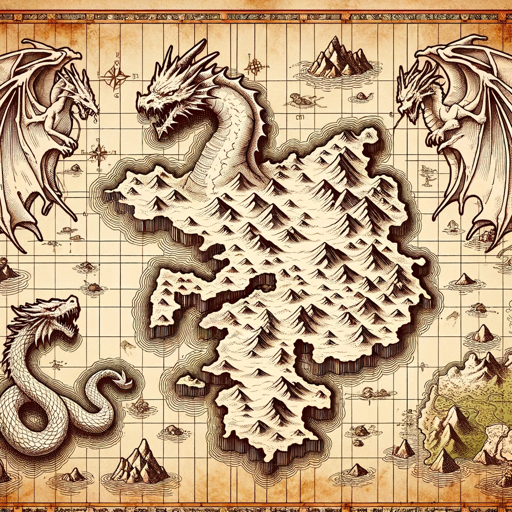Mythological-AI-powered D&D assistant
Enhance your D&D campaign with AI.
Create a magic shop in the market district of a city in the clouds
How do you get out of a grapple?
Create an inn keeper for a bar in the seedy part of town
Create a 2 challenge rating monster that could be found in a swamp
Roll d20 + 5
Related Tools
Load More
Mythical Map Maker
Crafts lore-rich descriptions and visual maps of fictional lands.

Greek Mythology
Greek mythology with vivid imagery

Ancient Warrior
Crafts scenes of an epic warrior in comic style armor.

神話→SF
神話の用語を入力するとSF風になる

The Chronicles of Aetheria

Mythos Mosaic 2.0
Storytelling platform v2.0 with interactive improvements, visuals, and persistent world.
20.0 / 5 (200 votes)
Introduction to Mythological
Mythological is an advanced AI-based assistant designed specifically for dungeon masters (DMs) to enhance their campaign and setting management. Its primary function is to provide comprehensive support by generating detailed content for various aspects of tabletop role-playing games (RPGs) such as characters, creatures, locations, and items. For example, a DM can use Mythological to create a richly detailed NPC (Non-Player Character) complete with personality traits, background, and equipment. Similarly, it can help design complex settlements with political, economic, and environmental descriptions, making world-building more efficient and immersive. Mythological's integration of tools like Python for data processing, DALL-E for image generation, and a browser for real-time information retrieval ensures that the content created is both vivid and accurate.

Main Functions of Mythological
NPC Generation
Example
Creating a unique shopkeeper character for a fantasy market.
Scenario
A DM needs a detailed NPC for an upcoming session. Using Mythological, they generate a shopkeeper character with specific traits, a background story, and a list of items for sale, complete with descriptions and prices.
Settlement Design
Example
Designing a bustling medieval town.
Scenario
The players in a campaign arrive at a new town. The DM uses Mythological to create the town's layout, political atmosphere, economic conditions, and notable buildings. This includes generating maps and digital paintings to visually represent the town.
Creature Creation
Example
Introducing a new monster to the campaign.
Scenario
For a challenging encounter, the DM decides to introduce a unique creature. Mythological helps by generating a detailed description of the creature, its abilities, and combat statistics, along with an illustrative image of the creature.
Ideal Users of Mythological
Dungeon Masters (DMs)
DMs benefit from Mythological by streamlining their preparation process. It helps them create detailed campaign settings, characters, and plot points quickly, allowing them to focus more on storytelling and player engagement. The ability to generate rich content on demand ensures that sessions run smoothly and unpredictably dynamic.
Game Designers
Game designers can use Mythological to prototype new game ideas rapidly. By generating different elements of the game world, such as characters, environments, and items, designers can experiment with various concepts and see how they fit together without spending excessive time on manual creation.

Guidelines for Using Mythological
Step 1
Visit aichatonline.org for a free trial without login, also no need for ChatGPT Plus.
Step 2
Familiarize yourself with the various templates available for generating content, such as NPCs, environments, settlements, creatures, equipment, and magic items.
Step 3
Use the provided templates to create detailed and customized elements for your campaign. Input the necessary details according to the prompts.
Step 4
Confirm the text details before proceeding to generate images with DALL-E. Ensure the descriptions are accurate and reflect what you envision.
Step 5
Review the generated content and make any necessary adjustments. Utilize the generated images and descriptions in your campaign to enhance storytelling and player immersion.
Try other advanced and practical GPTs
Music Marketing Mentor
AI-powered marketing for music creators

StableDiffusionWebUI /AUTOMATIC1111/CommentaryNAGI
AI-powered image generation for everyone

Run Coach Pro
AI-powered running plans tailored to you

Wellness Support Assistant
AI-powered emotional support and reflection

金庸武侠 (Wuxia World)
Explore Wuxia Worlds with AI-Powered Insights

Strategic Scribe
AI-powered clarity for your ideas.

RandomGirl
AI-powered personality simulation for every chat.

Auguste Escoffier
AI-powered French cuisine, tailored to you.

Charlie Munger Mentor
AI-powered wisdom for life and business.

WP Stats
AI-powered WordPress statistics tool.

TaxGPT
AI-Powered Insights for Your Tax Needs

Lyric Interpreter
AI-driven interpretations of song lyrics

- Storytelling
- Character Creation
- Campaign Design
- Map Generation
- Item Crafting
Detailed Q&A about Mythological
What is Mythological and what can it do?
Mythological is an AI-powered assistant designed for dungeon masters, providing tools and templates to create detailed elements for D&D campaigns, including characters, environments, settlements, creatures, and items.
How do I create an NPC with Mythological?
To create an NPC, use the NPC_TEMPLATE provided by Mythological. Fill out the concept, age, race, name, personality, and equipment details. Confirm the text details, then generate an action shot portrait using DALL-E.
Can I generate maps for my campaign with Mythological?
Yes, you can generate maps using the ENVIRONMENT_TEMPLATE and SETTLEMENT_TEMPLATE. Input the necessary details and generate a battle map or navigational map, which will be depicted with a 5'x5' square grid for easy integration into your campaign.
What types of equipment and items can I create?
You can create both mundane and magical items using the EQUIPMENT_TEMPLATE and MAGIC_ITEM_TEMPLATE. Provide the name, type, cost, weight, and description for mundane items, and additional details like rarity and attunement for magical items.
How do I ensure the generated content matches my campaign setting?
Provide detailed and specific descriptions when filling out the templates. The more accurate and vivid your descriptions, the better the generated content will match your campaign setting. Review and adjust as necessary before finalizing.